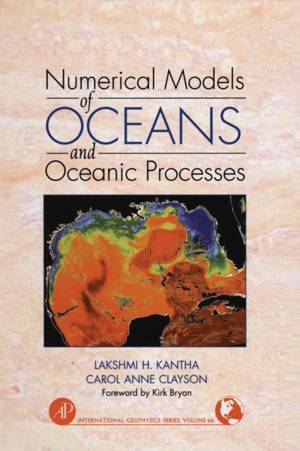
- Afhalen na 1 uur in een winkel met voorraad
- Gratis thuislevering in België vanaf € 30
- Ruim aanbod met 7 miljoen producten
- Afhalen na 1 uur in een winkel met voorraad
- Gratis thuislevering in België vanaf € 30
- Ruim aanbod met 7 miljoen producten
Zoeken
€ 149,95
+ 299 punten
Omschrijving
Oceans play a pivotal role in our weather and climate. Ocean-borne commerce is vital to our increasingly close-knit global community. Yet we do not fully understand the intricate details of how they function, how they interact with the atmosphere, and what the limits are to their biological productivity and their tolerance to wastes. While satellites are helping us to fill in the gaps, numerical ocean models are playing an important role in increasing our ability to comprehend oceanic processes, monitor the current state of the oceans, and to a limited extent, even predict their future state.Numerical Models of Oceans and Oceanic Processes is a survey of the current state of knowledge in this field. It brings together a discussion of salient oceanic dynamics and processes, numerical solution methods, and ocean models to provide a comprehensive treatment of the topic. Starting with elementary concepts in ocean dynamics, it deals with equatorial, mid-latitude, high latitude, and coastal dynamics from the perspective of a modeler. A comprehensive and up-to-date chapter on tides is also included. This is followed by a discussion of different kinds of numerical ocean models and the pre- and post-processing requirements and techniques. Air-sea and ice-ocean coupled models are described, as well as data assimilation and nowcast/forecasts. Comprehensive appendices on wavelet transforms and empirical orthogonal functions are also included.This comprehensive and up-to-date survey of the field should be of interest to oceanographers, atmospheric scientists, and climatologists. While some prior knowledge of oceans and numerical modeling is helpful, the book includes an overview of enough elementary material so that along with its companion volume, Small Scale Processes in Geophysical Flows, it should be useful to both students new to the field and practicing professionals.
Specificaties
Betrokkenen
- Auteur(s):
- Uitgeverij:
Inhoud
- Aantal bladzijden:
- 750
- Taal:
- Engels
- Reeks:
- Reeksnummer:
- nr. 66
Eigenschappen
- Productcode (EAN):
- 9780124340688
- Verschijningsdatum:
- 21/07/2000
- Uitvoering:
- Hardcover
- Formaat:
- Genaaid
- Afmetingen:
- 163 mm x 236 mm
- Gewicht:
- 1465 g

Alleen bij Standaard Boekhandel
+ 299 punten op je klantenkaart van Standaard Boekhandel
Beoordelingen
We publiceren alleen reviews die voldoen aan de voorwaarden voor reviews. Bekijk onze voorwaarden voor reviews.











